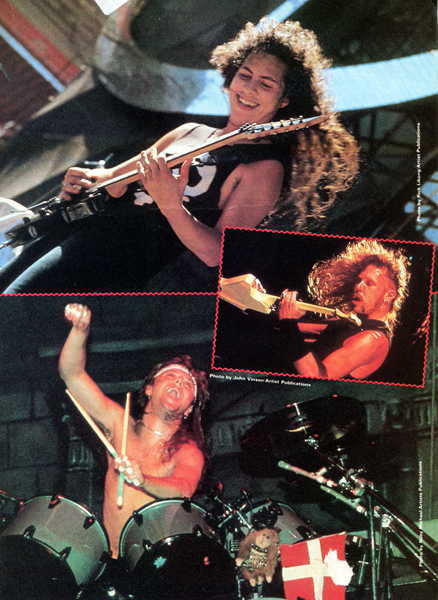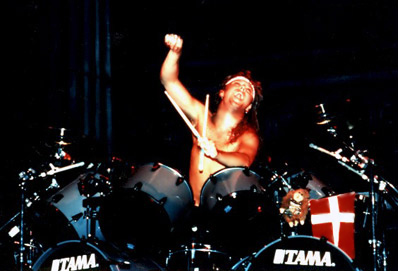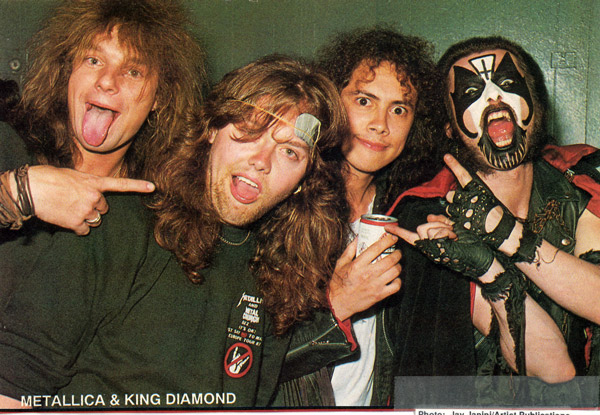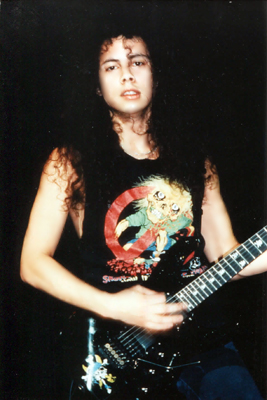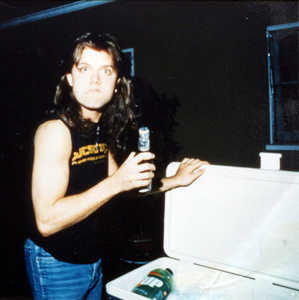
| Search JoyZine with Google Site Search! |
|
Metallica by Ron Quintana
In the beginning there was Lars.... But Lars' father, Torbay Ulrich, was an internationally-ranked pro tennis star in the '60s, who, incidentally, also owned a jazz club in Copenhagen. (Expatriate jazz great Deter Borden was Ulrich's godfather), and he saw Lars as following in his footsteps. So he decided to move the family to the U.S. and continue tutoring Lars into becoming a tennis prodigy. They moved to Newport Beach, just a few miles south of Los Angeles, in 1980. Lars brought with him a collection of albums by European heavy-metal bands then unknown in the U.S., including Diamondhead, Iron Maiden, Tygers of Pang Tang, Angel Witch and Holocaust—at a time when the American hard-rock scene was dominated by highly coiffed, smoothly-polished bands such as Styx, Journey and REO Speedwagon.
Lars had taken up drumming and was gradually losing interest in playing tennis all the time. Ironically, all the traveling he was doing on the tennis rounds actually hastened the end of his sports career, because he was visiting England frequently just as the new hard rock explosion was raging. Now known as the New Wave Of British Heavy Metal (NWOBHM), this included the flood of fast and heavy bands that followed in Motörhead's wake, most notably Iron Maiden, Def Leppard, Judas Priest, Saxon and Diamondhead.
Lars spent his spare time attending shows and festivals, collecting all the great new records and becoming fast friends with many of the bands. (In '81 he stayed at Diamondhead singer Sean Harris' house in Stourbridge, England.) By the summer of '81 Lars was making monthly trips to the San Francisco Bay Area from Southern California. He almost auditioned for the embryonic, soon-to-be-Seattle-bound band, Metal Church, but instead went back to L.A. to form his own band in late 1981. Still attending La Brea High School, he met guitarist James Alan Hetfield of Norwalk through mutual ads they'd placed in the infamous Southern California want-ad paper, The Recycler. He finally found a convert to his exotic brand of music in James Hetfield, a horror-movie fan who was raised with a strict Christian Science upbringing. James had had a couple of unsuccessful bands previously (Obsession and the Iron Maiden-ish Leather Charm), and had jammed with future Black N Blue guitarist Jeff Warner, but none of it was heavy enough for him. Lars and James clicked, and they named their new band Metallica, a name stolen from a San Francisco fanzine. In late '81 Brian Slagel (later president of Metal Blade Records) approached them to do a song on his Metal Massacre compilation record. Without a lead guitarist, they got a friend, Lloyd Grant (later of Defcon) to play on their first original song for the recording, "Hit The Lights." Shortly after this, things began to gel and the group solidified in early '82 with lead guitarist Dave Mustaine (later of Megadeth) and a pupil of Hetfield's, Ron McGovney (later of Phantasm) on bass.
In April, No Life 'Til Leather, Metallica's first official demo, was recorded and unleashed upon an unsuspecting public. Besides the earlier song "Hit The Lights", were two cover tunes, "Killing Time" by Sweet and "Let It Loose" by Savage. Three more songs were added by the summer, and those seven songs together with a cover of Diamond Head's "Am I Evil" became their standard concert repertoire. In those days the band played many cover tunes to augment their small collection of originals, some of which later appeared on B-sides and on Lars' compilation. Gradually, more of their own material took over the set and the "young metal attack" of Metallica played it's first real show at Radio City on March 14, 1982, and then again two weeks later at the Woodstock Club. At first, Hetfield mostly sang, but more and more took on full-time rhythm guitar duties, too. By the summer of '82 they were opening for the likes of Saxon, Krokus and Y&T in dumpy LA clubs such as The Concert Factory, and even their high school gym, in an attempt to play their music and win over a crowd in a land where poseurs ruled and anything fast and heavy was ignored. So when they got the chance to join the travelling Metal Massacre promo tour in September, they jumped at the chance. Neither Metallica nor the audience was prepared for what happened when they opened for Bitch in San Francisco that first time. The 'Tellicats got such an instantaneous, overwhelmingly positive response that they returned in October and November, and finally decided to move there in 1983. Previously, the band had been checking out a certain young bassist from Trauma by the name of Cliff Burton (at an LA Troubadour gig), as they were dissatisfied with Ron McGovney's musicianship and stage presence. It took a while, but they finally talked Cliff into leaving the hard-rockin' Trauma as soon as they moved to the Bay Area. With guitarist Dave Mustaine, the three moved to San Francisco in February 1983 when Cliff Burton, the bassist they were determined to have in the band, refused to move to Los Angeles. In February of '83 Metallica moved north into Mark Whittaker's house (Exodus' then-manager) in El Cerrito and jammed with Cliff for the first time. Burton, a more accomplished musician than the other members of the nascent Metallica, was an anomaly in Castro Valley, wearing decidedly retrograde bell-bottom jeans in a tight-pants era, and unhip Lynyrd Skynyrd T-shirts.
After a few concerts in small San Francisco clubs, the band moved to the East Coast, summoned by a record dealer operating out of a stall in a flea market who had heard a demo tape and offered to help the band make a record (and so formed Megaforce Records, which later signed such bands as Ministry and Testament). After a scary cross-country trip and a couple of weak shows in New York, the rest of the band decided Dave Mustaine was too unstable, so they fired him and called back home for Exodus guitarist Kirk Hammett to come fill in for a couple of gigs. They had just enough money to get him cross country, and no money to send him back if it didn't work out, so they crossed their fingers and prayed. Hammett, born and reared in the heart of the Mission District in San Francisco, was a teenager when his family moved to the San Francisco East Bay suburb of El Sobrante. There, he became friends with another unlikely character in the all-white, middle-class neighborhood, Les Claypool, who later led Primus for a number of years. Kirk stayed, officially joined the band, and in April and May of 1983 Metallica recorded Kill 'Em All. Released in August, the album kicked off their first nation-wide tour in September of that year, opening for Raven. The unknown band launched a 40-date tour, zigzagging across the country in a trailer home, and Kill 'Em All sold an astonishing number of copies for an independent release. A second album, Ride The Lightening, was picked up for distribution by Elektra Records, which signed the band. The third album, Master Of Puppets, broke the gold-record barrier in 1986, when bassist Burton was killed in a bus crash on a dark, icy Swedish highway. The band auditioned a number of prospective replacements, including Hammett's high school friend Claypool, before settling on Jason Newsted, who belonged to a Phoenix-based band called Flotsam and Jetsam.
The fourth Metallica album, ...And Justice For All, led to a spot on the summer stadium tour Monsters of Rock, headlined by Van Halen. Day after day, Metallica won converts, sending the packed crowds in gigantic stadiums across the country into a thrashing frenzy, and selling more merchandise than any other band on the concert bill, including Van Halen and the Scorpions. By the end of the band's own headline tour, the album had sold 3 million copies around the world. Radio and MTV had barely begun to discover the band, but Metallica had arrived. Still, nothing prepared the band for what came next." I knew we had a lot of strong material and the material would go the length," Hammett said of the subsequent album, Metallica. "But I'm not the kind of person to count my chickens, whereas Lars was totally convinced we had the next Back In Black—and he was right." This highly original band rewrote the rules of heavy-metal rock over the past decade, practicing a deeply personal approach to an often clichéd field of music, bringing previously unknown subtleties and a fierce commitment to the group's music. Metallica was suddenly and spectacularly successful, selling more than 12 million copies worldwide. The group became one of the most popular bands on the planet and went on what must have seemed, at times, an endless tour, reaching from Moscow to Singapore. Added Ulrich, "Selling 12 million records doesn't happen every five minutes. We took everything we could and pushed it as far as we could. A lot of opportunities presented themselves because of the success. You want to play Thailand? Sure, why not? We did a thorough job of pushing the envelope."
Metallica is a band that has always very much kept its own counsel. Ulrich is clearly the driving force within the group. "His intensity motivates us," Hammett said. And the chestnut-haired drummer with the gaggle of bracelets on his wrist has definite ideas about the philosophy that guides the band. The group he formed to pursue a specific vision is the only one he's ever worked in. Metallica's music evolved out of the creative collaboration he set in motion. "I get pissed off when I hear this shit: 'Give the people what they want,' he said. Give us what we want. We have a kind of stubborn arrogance and that's carried us through the years." Hammett takes his hollow-body guitar out to a school to try and swing with a roomful of music students learning jazz, but he also sits around his flat in a T-shirt with a picture of Mississippi Delta blues man Robert Johnson on it, picking out old blues runs. Newsted has infected both Hammett and Ulrich with his love for traditional blues. Vocalist Hetfield has been listening to a lot of country music lately. "When we get together next summer to record an album, it's always interesting to see what happens. Whatever comes out of it will be whatever we feel at the time. There's no formula." Hammett agreed. "Tour by tour, we change so much, as people, as musicians," he says. "That's part of the dynamics of Metallica, the chemistry. We have as little an idea as anyone else what it will sound like." Interview with Cliff Burton |
